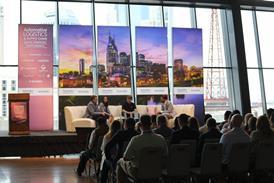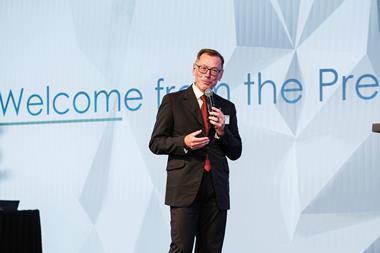 Ashok Leyland’s head of vehicle distribution, Chandrakant Mishra reveals how the OEM is trying to maximise its outbound logistics efficiency as much as the Indian landscape will allow.
Ashok Leyland’s head of vehicle distribution, Chandrakant Mishra reveals how the OEM is trying to maximise its outbound logistics efficiency as much as the Indian landscape will allow.
Unpaved and congested roads; long queues of vehicles waiting at state borders to pay various tolls and taxes; limited handling and storage at ports; burdensome and varying regulations across the country; high damage rates and inefficient routes with too many empty backhauls. The challenges facing many carmakers in India are by now familiar, if not cliché.
For commercial vehicle makers, the problems are similar, if not worse. Lower volumes mean a lack of scale, which can make it harder to use standard equipment and services. Meanwhile, it is necessary to obtain additional permits to move large equipment, which are often different depending on the state, leading to further delays at borders. There are also many restrictions on trucks entering city limits during the day.
These issues are par for the course for Ashok Leyland, the second-largest commercial vehicle manufacturer in India, and the fourth-largest producer of buses in the world. Chandrakant Mishra, head of vehicle distribution and outbound logistics, admits openly to these challenges, and hopes as fervently as any logistics executive for reforms in regulation and investments in infrastructure.
Like others in the sector, Mishra anticipates efficiencies that could result from the introduction of India’s long-awaited Goods and Service Tax (GST), which would centralise many of the separate taxes and duties currently paid across multiple states. A bonus for CV-makers would be if the change could help unify necessary documentation and permits, with a single document and invoice covering the entire country. Mishra estimates that 10-15% of a driver’s time is currently spent on permits required for interstate movement.
He is also taking an active role in planning and experimenting with a number of multimodal routes, including rail to ports, as well as short-sea shipping for both domestic deliveries and exports to nearby countries. Such services, however, depend on enough companies using them, and most remain in trial phases until they become commercially viable for LSPs or OEMs. In some cases, such as those involving short-sea shipment, there are regulatory hurdles as well.
However, whether it is multimodal services or the long-delayed GST, Ashok Leyland cannot afford to wait longer than any other company for conditions to change around it. In that way, Mishra and his team have set a number of achievable goals that the company can better control itself, including a switch from moving trucks individually by ‘jockey’ transport, to moving more by truck-on-truck carriers, as well as improving the tracking of vehicles by GPS across the supply chain. Furthermore, the manufacturer is in the process of a dramatic shift in order management, aiming to increase significantly the number of vehicles that are made-to-order versus made-for-stock, which Mishra expects will lower inventory and ultimately improve logistics by eliminating more storage and handling.
A complex, challenging network
Ashok Leyland’s seven production plants are spread across the length of India, while its distribution and export network makes its outbound logistics lengthy and complex. The company has four plants in southern India, with one based in Chennai and three in Hosur, 190km west of the city. It also produces in Bhandara, 900km east of Mumbai, and in Alwar and Pantnagar in northern India. Its domestic production capacity is approximately 135,000 vehicles annually, of which about half is allocated to truck production, with the rest divided between both light commercial vehicles and buses.
Domestically, 60% of Ashok Leyland’s vehicles move by truck carrier and 40% move by ‘jockey’ transport (when the vehicle is driven individually), while it is about 50:50 for fully built buses. Bus chassis, including the cab and undercarriage, move entirely by jockey transport.
Some vehicles move first to a third party for body building and then to the sales region; others ship directly to the destination. The company ships 85% of its finished units to dealerships, and 15% directly to the customer. Ashok Leyland operates five sales yards throughout the country, in Pantnagar, Alwar, Bhandara, Ennore (near Chennai), and Hosur. At the sales yard, the main operations include quality inspection, storage, damage estimates and repair, PDI, and washing.
For its outbound logistics, the company has ambitions to cut its delivery time to customers while also reducing its damage rates, according to Mishra. For example, he would like to cut the cost for domestic transport in India to fewer than 20 rupees (32 cents) per kilometre, and 40 rupees per kilometre for exports.
For Mishra, vehicles should also arrive to customers on time, without damage, and with zero kilometres on the odometer. To do so, the company intends to move away from jockey transport towards full use of vehicle carriers, as much as costs allow.

Along with a lower damage rate, truck-on-truck transport also helps to relieve issues around driver shortages, as well as increasing load factors. The company has increased capacity per trailer from 1.9 three years ago to 2.3 as of early 2014. “If government regulations change on weight and dimension restrictions, it could increase to 3.5 units,” says Mishra.
While the company’s manufacturing is predominantly based in India, it has joint-venture bus production in the United Arab Emirates, with the Ras Al Khaimah Investment Authority. It also has a British subsidiary, Optare, based in Leeds, capable of manufacturing diesel, hybrid, and electric buses. Meanwhile, more than 10% of the vehicles built in India are exported, with most destined for southern Asia (70%), as well as to the Middle East (15%) and Africa (10%), and smaller destinations in South-East Asia, Latin America and Russia.
Export pain points
Of Ashok Leyland’s exports, 80% move by ship and 20% by road to neighbouring countries. While it ships most of its vehicles by ro-ro vessels, as well as some fully built vehicles in containers, around 20% of exports move as knockdown kits to Africa, Russia, and the Middle East for assembly. Mishra says the OEM is also looking to increase its supply of finished products by container.
One of the major difficulties affecting Ashok Leyland’s international shipments is port congestion, as India suffers from a limited number of ports with effective service for ro-ro vessels, as well as a lack of dedicated space for handling and storing commercial vehicles inside the port. Many facilities also lack sufficient road and rail connections.
For Ashok Leyland, some of its export points are far from its plants. Vehicles produced in northern India must travel more than 1,600km to the port of Mumbai, which handles around 60% of the company’s exports. By comparison, plants in the south are closer to the port of Chennai, which handles 30% of exports, as well as the nearby port of Ennore, which handles 10%. Mishra says that India’s government is working to establish newer and better ports. Many private firms are also joining in to start new and efficient ports for container ships as well as ro-ro vessels. Recently established ports or ones under development for ro-ro include Krishnapatinam, Pipavav, Mundra, and Kandla.
Looking to multimodal
Ashok Leyland has also been experimenting with rail logistics from Pantnagar to Chennai, with jockey transport used from the plant to the rail yards, and for final distribution. “We have tested the shipment of 60 heavy-duty units, which takes four days, reducing transit time by 50% compared to road,” explains Mishra. “We can cover 600-700km per day. Rail also avoids the damage risk of an open-type carrier.”
Ashok Leyland is also working with governmental and other agencies to combine rail, road, and ro-ro vessels both for exports and domestic deliveries. One notable example is a potential short-sea route for vehicles originating in Pantnagar: vehicles would move by jockey transport to Mumbai, then by ro-ro vessel to Chennai, and finally by jockey transport to the distribution point. “However, the Mumbai to Chennai ro-ro option is not commercially viable at this point,” says Mishra. “Volumes and timing would support one-way movement but not round-trip.”

“Our idea is to try to obtain permission to transport our products from Chennai north to Kolkata and then by jockey transport to Bangladesh. Although transporting from Chennai to Kolkata is permissible, the law allows a carrier to provide either domestic or international transportation, but not both on the same trip,” points out Mishra.
Even the ro-ro options that are currently legal are at least six months to one year from implementation at this point, he admits. There is also a substantial inland waterway transit system proposed in India, which Mishra says would improve export logistics by better linking the hinterland to ports.
Taking control of the supply chain
While Ashok Leyland faces limits to its transport network depending on regulations and infrastructure, it has tried to take more control of tracking shipments by using GPS technology. The company’s internet-based tracking system monitors vehicle pickup, delivery receipt, and all defects or damage. It updates the tracking of its product locations twice daily, while for road carriers inputs from mobile phones determine their exact location.
This system has been in place for about one year, having most recently been rolled out for jockey drivers. “We have used the technology to help reduce the road transit time of jockey transporters by 33% within the past three months,” says Mishra, adding that previous tracking was poor by comparison. “A year ago, jockey drivers would manually notify the company of its location. Now, filling diesel transmits the location online. Within the next six months, the mobile provider will provide the driver’s exact location.”

Another notable method of improving efficiency, which circumvents India’s infrastructure limits, is to increase made-to-order vehicles. Ashok Leyland now delivers about 10% of its products directly to the customer instead of supplying them through its sales yards. “This affects our costs of storage and delivery positively,” says Mishra. “Previously, we would send vehicles to the sales yard, where local billing would occur.”
One disadvantage of this method, however, is that eliminating the yard means that Ashok Leyland has less opportunity to survey vehicles for damage, which means that damage may only be noticed at its final destination.
Nevertheless, Ashok Leyland’s goal is to increase its made-to-order production to more than 85% of the total next year, including 15% being special orders. This change would result in both lower and less ageing vehicle stocks.
The target may not quite be attainable so quickly, admits Mishra, who would be happy to see half of units made-to-order within the next two years. However, ambitious targets, whether shifting all vehicles onto road carriers, or reducing defects in delivery, are important to the company. India will need time to build all the roads and ports it needs, and lighten its regulatory burdens; in the meantime, Mishra aims to improve or influence logistics to the best of his ability.






































